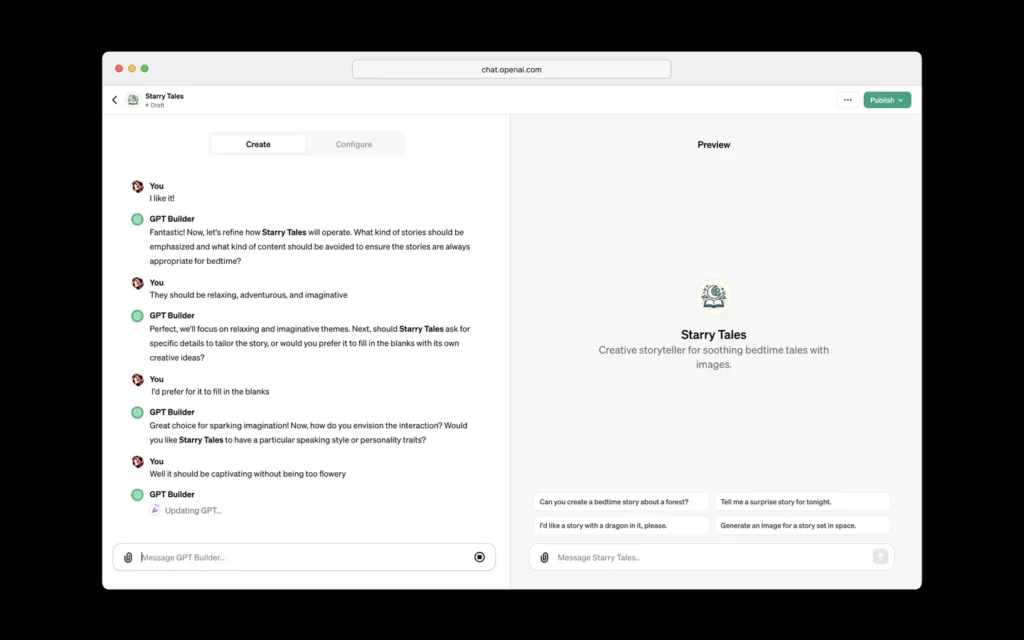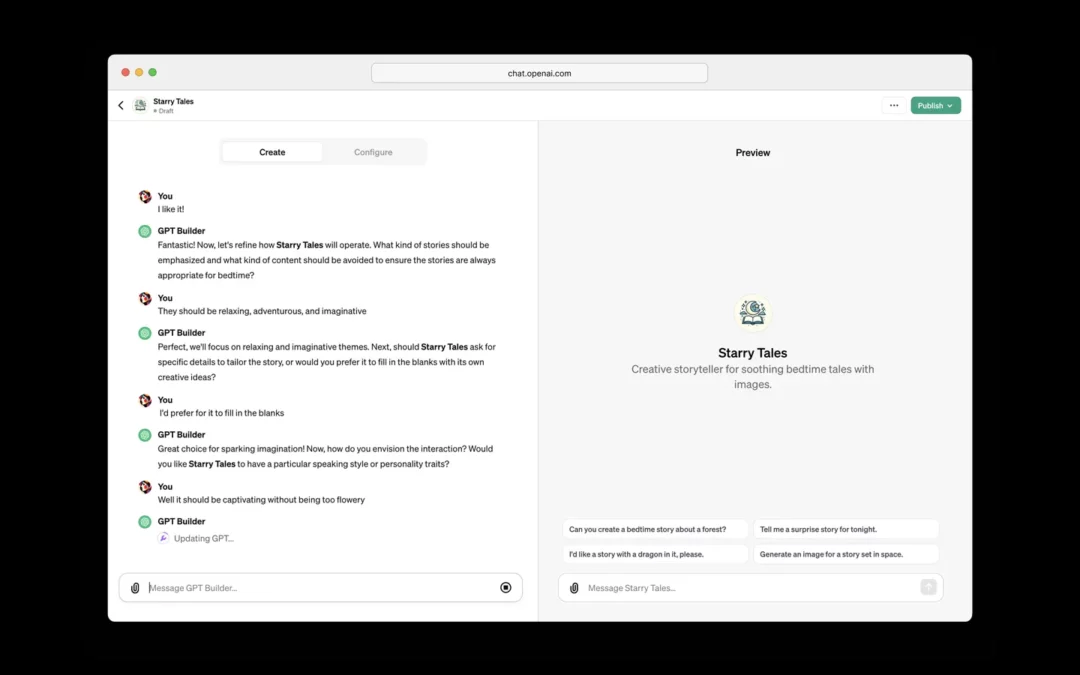OpenAI plans to release no code tools so that anybody can build what they call GPT’s for their upcoming GPT store. Similar to how the App Store adds value to Apple products, OpenAI’s GPT Store will be a way for developers to submit GPTs (think “apps”) that enrich the core ChatGPT product experience.
ChatGPT reaches an impressive 100 million weekly users, making the GPT Store a uniquely large opportunity for third parties to reach a massive audience without needing to write any code.
What does this No Code promise look like from OpenAI?
Building GPTs with No Code
Currently ChatGPT supports Custom Instructions for power users who want to tailor ChatGPT to specific use cases. This has really boiled down to users maintaining a list of carefully crafted prompts and instruction sets, manually copying them into ChatGPT. Announcements at DevDay propose more features tailored to managing these Custom Instructions and saving them as GPTs.
The new no code interface will let you define how you want a GPT to interact with people before you publish. Each GPT that you create can be granted access to OpenAI’s Code Interpreter tool for writing and executing software, DALL-E, web browsing, and more. Not to mention the announcement of Copyright Shield.

Combining these features with the ability to add custom data and hook into external services for accessing data like emails, databases, and existing integration ecosystems like Zapier show that OpenAI is committed to helping its users to create GPTs without writing any code.
The Enterprise Opportunity for No Code and ChatGPT
Scale and serious investment from OpenAI are obvious leverage when considering an investment in GPT creation as a business. You can draw comparisons to the rapid reach and growth of any significant app store from Apple to Salesforce. At the same time, its important to recognize the risk and reward of deploying part of your value proposition to consumers through ChatGPT.
The non-obvious risk is abstraction from your currently deployed and proven methods of customer interaction. Similar to how Google presents summarized content from publishers in a Google Search, ChatGPT takes users time away from your website, app, or other established channels of customer experience. In fact, this is a significant goal of OpenAI – increase daily or even hourly user engagement with ChatGPT.
Mitigating this risk comes down to key design decisions in your GPT. Specifically, what custom data do you make accessible to ChatGPT and what external events can you use to build a bridge back to your core offering?
The ultimate reward is ChatGPT as a channel for customer acquisition. And while we still have more to learn about the revenue sharing economics of GPT usage that OpenAI is promising, you could realize a close to negative CAC if you are being paid a significant revenue share from the use of your GPT and you build an effective bridge to your core service in the GPT itself.
ChatGPT App Store Developers
We will soon see a boom of agencies offering GPT development services – but be cautious. Nobody is really an expert in building GPTs yet. While there are some impressive prompt engineers, few agencies will specialize in key design decisions that will influence customer acquisition cost through this channel.
It may be a better bet to enable existing team members who have keen interest in ChatGPT to propose a business case and model for how to drive new revenue from the launch of a branded GPT.
No Code Platforms + OpenAI GPT Development
A more interesting go-to-market partnership could be with a no code platform who wants to build expertise in OpenAI development. Take Decisions.com for example, who is starting to promote OpenAI as a preferred method of adding AI to its existing workflow automation capabilities. A partnership here could unload some of the technical unknowns around extending existing systems and give your team speed and flexibility in how to design the bridge between GPT and your core product.
Most Enterprise teams will underestimate how much additional development work will exist at the seam between the no code GPT building and the external actions or data that will make the GPT unique. Partnering with a no code platform can empower a smaller team without developer resources to focus on the design of customer acquisition.
Concerns around managing what data is made available to GPT services, how much of the core products capabilities do we make available in the GPT service, and other design decisions can actually be governed, monitored, and improved over time with a platform like Decisions.
If you are interested in a exploration call on this subject you can reach out to us through the Need Advice button in the top left of every page on NoCodeDev. Just mention this article.
How Do You Make Money from the OpenAI App Store?
The biggest question that we all still have for OpenAI is what does the revenue share look like? Few details have been given, but the context suggests it may operate more like YouTube’s revenue share than the Apple App Store combo of app purchases and in-app transactions. Though I’m sure a combination of these models is being considered.
Our best guess today is a bias toward payouts based on user engagement, so more similar to YouTube’s model. GPT access is probably free in general to encourage user engagement. OpenAI may pay out a revenue share based on the level of engagement with your GPT. Will there be “in-chat transactions”? Possibly, but no details have been given to date.
In our opinion, the best way to monetize the GPT Store may not be from a promise of some form of user engagement revenue sharing. Instead, businesses should focus on customer acquisition by providing unique value in the form of data and external events that can be shared or triggered with a prompt from a ChatGPT user.
Can you create a new account in your core product from a ChatGPT conversation?
Can you start a free trial in your core service or send a product recommendation email to a ChatGPT user based on their conversation?
Can you expose your e-commerce product catalog in a unique contextual way to a ChatGPT conversation that results in a purchase without feeling like a promo?
We’ll be able to ask better questions as OpenAI releases more information in the coming weeks.


